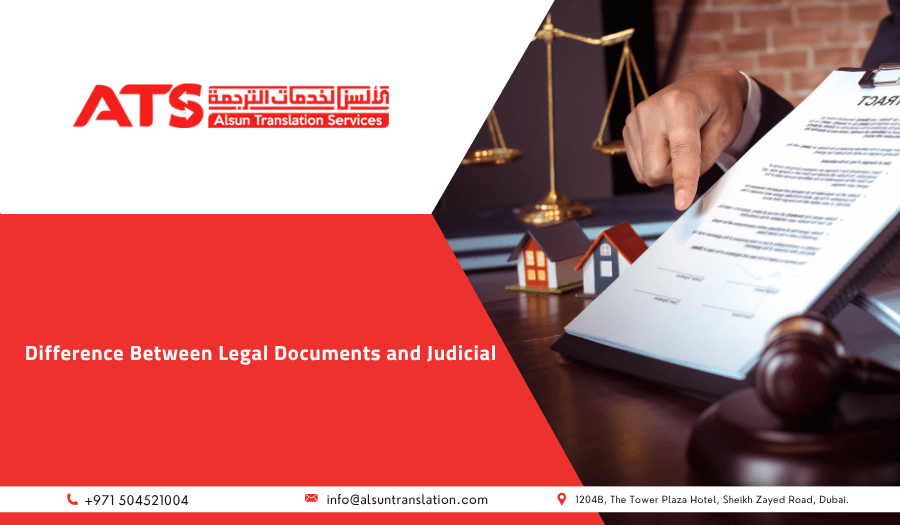Some translators believe that both legislative texts and marriage certificates fall under the same type of documents: Legal documents. Experienced translators, however, know that’s not true.
The former falls under the umbrella of legal documents, while the latter is an example of a judicial file.
If you’re interested to learn more, we’ll explore the difference between legal documents and judicial in this post.
Table of Contents
Definition of Legal Documents
In general, a legal document is any document that outlines and formalizes the details of an agreement between two or more parties. It’s a powerful tool that upholds responsibility, enforces rights, and ensures all procedures occur under the vigilant watch of the law.
Importance of Legal Documents
Legal documents are the backbone of many legal and business activities. They serve as clear proof of what was agreed or decided, and they protect the interests of everyone involved. Here are a few key points about their importance.
Establishing Rights and Obligations
Legal documents establish and record the legal relationships between parties. For instance, a signed contract formally sets out the role of each party involved and the expected outcome/consequences if one of them fails to fulfill their roles.
It’s a layer of legal protection, guaranteeing that each party remains in a safe zone once a deal has been made.
Preventing Potential Disputes
By clearly outlining the terms of the collaboration between two parties in writing, legal documents help avoid misunderstandings. If a disagreement arises later, the written terms serve as evidence of what was originally intended.
Acting as Evidence in Court
Legal documents can often be used as evidence in a court case. For example, if a contract dispute ends up in court, the contract itself is a key document the judge will read to decide the rightful side.
Courts will review the exact wording and signatures on legal documents to interpret the parties’ rights.
Key Features of Legal Documents
Legal documents often vary depending on their type. However, they also share a few features, including:
Formal Structure
The structure is mostly what defines a legal document. It usually includes:
- A title
- Definitions section
- Clauses (terms and conditions)
- Signature blocks
Required elements
Almost all legal documents must identify the parties involved, the date of signing, and must be signed by the parties. Many also require witnesses or notarization. This adds extra security that the document is genuine.
Clear Terms
The content of any legal document must clearly state the intentions of both parties. Clauses in the document outline rights, duties, deadlines, and conditions, and because the precise wording matters so much, vague or contradictory language is avoided.
How Legal Documents Influence Legal Proceedings
Legal documents play a central role in any legal case or transaction. Here’s how they influence legal processes:
Establishing the Basis of a Case
Every legal case starts with documents. For example, civil lawsuits begin with a complaint or petition, which is itself a legal document laying out the plaintiff’s claims. This means the initial legal documents set the issues for the court to resolve.
Clarifying Facts and Issues in Court
Well-prepared documents make the facts and issues clear to both sides and the judge in court. Ambiguous or incomplete documents can complicate a case and cause delays or mistakes.
That’s why clarity and precision are crucial in legal paperwork. They help avoid misunderstandings that can otherwise lead to complex rulings.
Acting as Evidence and Record
A lot of legal documents become evidence. Contracts, affidavits, and recorded statements are all presented to a court as proof of the facts. Even correspondence or financial records can become evidence if they are signed or official.
These types of documents tend to shape the court’s view and control the outcome of the case.
Common Examples of Legal Documents
Common examples of legal documents include:
- Contracts
- Deeds
- Wills
- Affidavits
- Patents and trademarks
- Commercial agreements
- Court filing forms
Definition of Judicial Documents
A judicial document refers specifically to papers issued by a court or connected to a court case. That includes summons, complaints (the first filing in many lawsuits), court judgments, injunctions, restraining orders, and applications to the court.
In general, judicial documents are the official records that a judge or court clerk creates or certifies during a legal proceeding.
Importance of Judicial Documents
Now that you understand the definition of judicial documents, let’s see what makes them so important.
Enabling Accountability and Appeals
Because judicial documents are authoritative records, they have the power to enable appeals and public review. If a party believes an error was made during a case, they rely on the written records, whether briefs, orders, or evidence, to challenge the ruling. Without these records, an appellate court could not review the case.
Enforcing the Law
Judicial documents are the tools that help enforce the court’s power. A court’s order, like a ruling in a divorce case or criminal sentencing, is legally binding on all parties.
It sets out what the parties must do (or not do). The effect of these rulings depends on the document’s authority as a court-issued paper.
Establishing Transparency and Trust
In some cases, the legal system publishes judicial documents in public to help citizens understand how courts make decisions. Openness and transparency help build trust in the legal system.
Key Features of Judicial Documents
Judicial documents have several characteristics that distinguish them from other papers. These include:
Issued by the Court: A judicial document is normally created by or filed with a court. It bears the court’s letterhead or official seal and often includes the case number.
Formal Format: Judicial documents have a strict format. For example, a court judgment typically begins with the court’s name, case number, parties’ names, and then the facts and legal reasoning. Orders and motions include references to the parties’ names and legal statutes.
Signatures and Seals: Judicial documents are signed by a judge or the court clerk, and usually stamped with an official seal to prove their authenticity.
How Judicial Documents Influence Judicial Decisions
As court-issued files, judicial documents can affect the outcome of any court case.
Reference for Judges
A judge deciding on a motion will carefully read the motions and briefs, which are judicial documents, to understand each side’s arguments. Then, they’ll write their opinions and orders based on the information presented in these judicial filings.
Setting the Final Outcome
The final judgment or order in a court case is itself a judicial document that becomes the law for that case. It binds the parties to the outcome.
This shows the power of judicial documents: once issued, the parties must follow them.
Setting the Record in Court
If a text is not in a judicial document, it doesn’t exist in the eyes of the court. That means evidence not submitted will not be considered. So, attorneys must carefully submit all relevant judicial documents, like exhibits or affidavits, to help the court reach a fair ruling.
Common Examples of Judicial Documents
There are various examples of judicial documents, including:
- Court complaints/petitions
- Motions and pleadings
- Court orders
- Transcripts of hearings
- Affidavits and Subpoenas
- Sentencing documents
Difference Between Legal Documents and Judicial Documents
|
Aspect |
Legal Documents | Judicial Documents |
| Definition | Written documents that record or establish legal rights, duties, or agreements |
Documents relating specifically to court cases, including summons, complaints, and orders |
|
Issuer |
Usually drafted by private parties, businesses, or individuals | Issued by the court, judge, or court officials. |
| Purpose | To define legal relationships outside or inside the court. They set out rights and obligations |
To document the progress and outcome of legal proceedings. |
|
Impact |
Bind the parties under law; enforceable through courts if breached. |
Bind the parties according to court commands and govern the progress of legal cases. |
Legal Translation Services in Dubai
Judicial and legal translations are two of the most coveted types of translation on the market, but they’re also two of the most challenging. Not only is it necessary for translators to find accurate equivalents of complex concepts and terminology, but they also need to maintain the legal tone in the target language.
Needless to say, it requires the utmost skill and experience to produce an accurately translated legal and judicial text. That’s where Alsun Translation Services comes in.
With a qualified team of talented translators and a knack for using the most advanced translation tools, we offer the highest quality at the most affordable rates.
Read More: Import and Export Translation Services.
Conclusion
At first glance, there may not seem that much of a difference between legal documents and judicial, but after careful consideration, you’ll see that it’s night and day. Either way, no matter what type of legal/judicial documents you want to translate, you need skilled translators.
And Alsun Translation Services’ team has proven itself capable of tackling the most complex translation document on the market. So, give us a call, and we’ll deliver the quality you’re looking for.
Read More: best legal translation services in Dubai.
FAQs
Do you use AI in your translation?
No, we trust our team to produce high-quality work without needing the assistance of AI.
What languages do you translate to and/or from?
Our versatile team offers translation services in various languages, including Arabic, English, French, Spanish, Greek, German, Italian, and more.
How much does your translation take?
That depends on the complexity of the text, the word count, the language pair, and the deadline. That said, we try to deliver our translation as quickly as possible.



